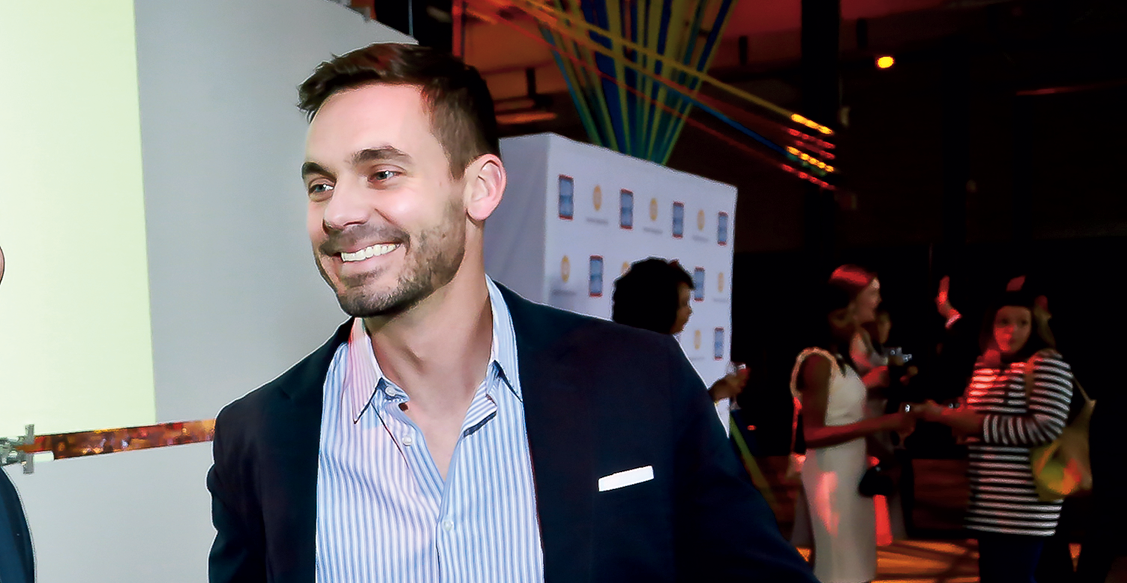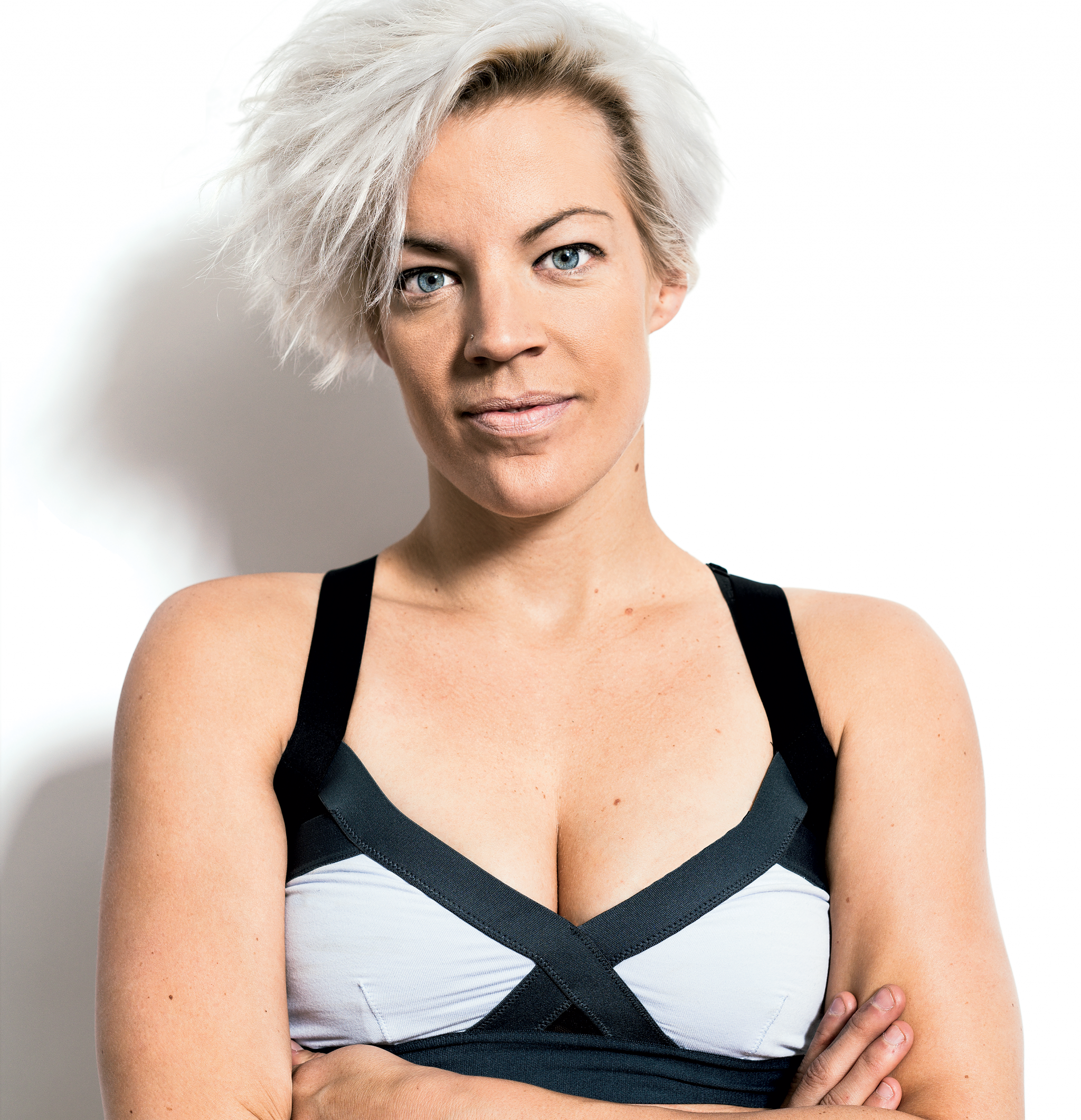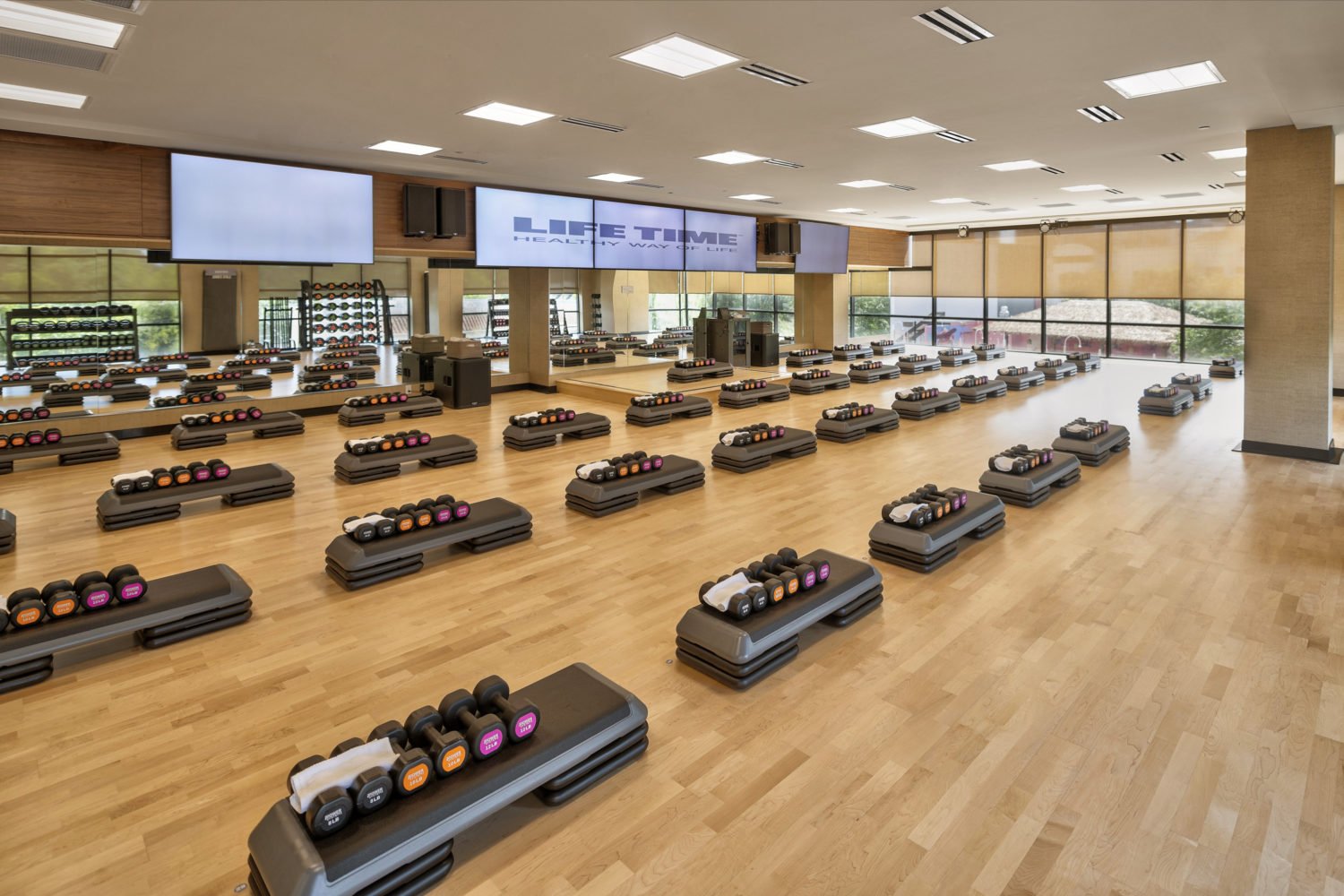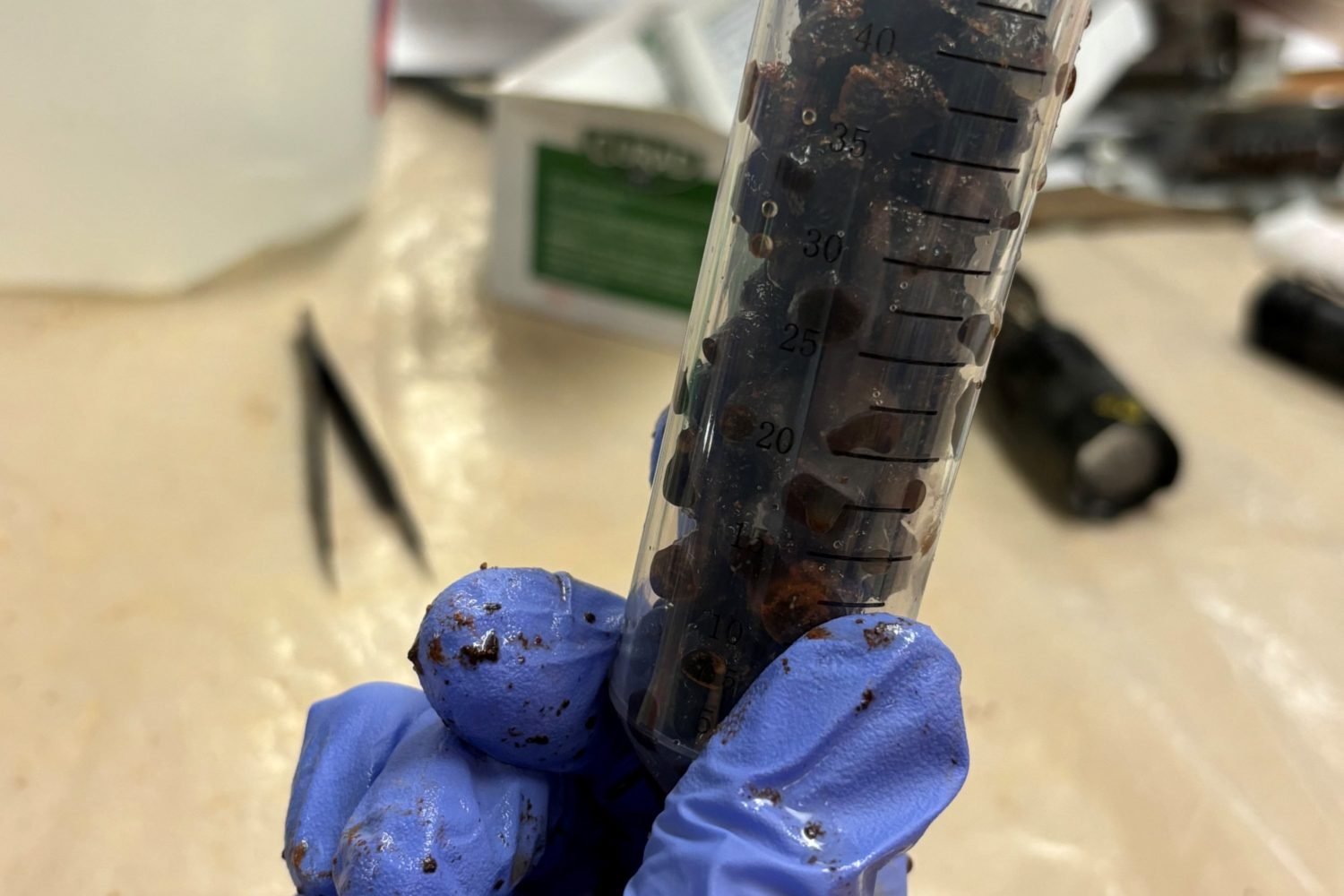Anne Mahlum, founder of the Solidcore boutique-gym chain, is an almost comically bad driver. I learned this one day as we drove in her Audi Quattro to downtown Bethesda, where her ninth studio was soon to open. Mahlum started the trip one-handed, simultaneously negotiating with a construction worker on the street and participating in a conference call on her iPhone. She texted and replied to e-mails and checked her GPS. At a stoplight, she applied deodorant.
I’ve been to war and disaster zones. But this, on the pavement of Wisconsin Avenue, was the first time I was convinced I’d die reporting a story.
Mahlum’s contractors were trying to explain potential delays at the new studio—workout machines hadn’t shipped, there was a standard waiting period, yadda yadda yadda. Her free right hand churned an imaginary bingo crank faster and faster, as if the prize were that everyone would hurry up and get to the point. “I’m not okay with waiting,” she snapped. “Everyone needs to get onboard with that.”
Saying Mahlum craves productivity is like saying Kim Kardashian kind of likes social media. In college, she created schedules so elaborate they included how long she was allowed to shower. She says she’d go out drinking only when she had an early-morning commitment the next day and so would be forced to get up. She graduated in three years—with two degrees. Today, at 36, she doesn’t want kids in part because you can’t “pivot” with them.
Yes, that is her word.
Barely three years ago, Mahlum started Solidcore, which has turned into the most successful homegrown fitness chain Washington has ever seen. Offering essentially one workout—a 50-minute session on a single exercise machine—the company was valued earlier this year at $30 million. And it’s on a growth blitz: Solidcore now has 11 studios locally and is planning to have 50 across the country by the end of 2017.
What Mahlum is selling isn’t just a place to sweat—though there’s plenty of that, a workout so intense that it hurts to laugh for days afterward, even as it prompts users to post reviews like “more challenging than my first marathon” and to tweet “should be called SolidSore. #ouch.” As the company’s website says, Solidcore is also “on a serious mission to help you create the strongest version of yourself.”

It’s the kind of line you could find tacked onto any high-end temple to working out these days. Boutique fitness has been likened to the new fashion, the new nightclub, the new place to network, and, according to researchers at Harvard Divinity School, the new religion. It’s all so amazing and enlightening, finding your best self, discovering what you’re capable of (the growth within!), it’s easy to forget that what lies beneath the gospel is a business.
Until you meet Anne Mahlum.
Mahlum is as focused as the workout she sells. Rather than let her $1.2-million townhouse sit fallow when she’s away, she rents it out on Airbnb for $590 a night. She has a side gig as a motivational speaker, telling her story, she says, of “finding a purpose, taking the risks to be happy” for $10,000 a speech. She’s relentless in pursuit of her goals, whether personal (for 2016, “buy a lake house”; “2 trips abroad and 10 trips domestically with the love of my life”) or professional (“employ 100 people, either full-time or part-time”; “invest financially in another entrepreneur”). Which may be why Mahlum, at this moment of seeming triumph, has been in a pair of intense battles. One of them was an ugly court fight with Sebastien Lagree, the Los Angeles fitness-machine entrepreneur who accused her of breach of contract and false advertising and in the process exposed the inner workings of the high-end fitness industry. The other was more personal and more maddening: a lawsuit by her ex-boyfriend, Brennan McReynolds, who claimed to be an owner of Solidcore.
The drama could have cost Mahlum millions. But it tells you everything you need to know about her that she manages to find the positive in the whole mess, and places the court battles in the context of her—wait for it—efficiency. Her employees, she says, were probably grateful for the distraction: “It’s almost like ‘Thank God for the lawsuit because if Anne were not slowed down a little bit, we’d all be running around even crazier and opening ten more studios.’ ”
***
Mahlum (pronounced Maa-lum, not May-lum, she corrects) is a striking sight in DC, with spiky platinum-blond hair, a nose piercing, and a thing for booty shorts. It’s possible the only clothing she owns that hides her abs is a winter coat. “Was politely asked by bank manager if I could please wear a ‘real’ shirt next time,” she posted on Facebook last year. “I guess I’ll be sewing two crop tops together.”
Mahlum discovered Lagree’s Megaformer machines on a trip to California in early 2013 and inquired about licensing his workout. Several months later, she and McReynolds moved from Manhattan to Washington. Two Megaformers were soon delivered to their Lanier Heights apartment and placed in the master bedroom so Mahlum didn’t have to waste time waiting for the studio to open to train instructors. By November of that year, the first Solidcore debuted in a former Adams Morgan Video King.
Mahlum says she used $175,000 from her savings for the start-up costs—and pointed out, in neat charts she made for her financial planner, that she’d be fine even “if the business absolutely tanks.” It didn’t. In very little time, according to Mahlum, Solidcore was turning a profit. She ran a very low-fat operation: Solidcore initially operated with no front-desk staff. Mahlum felt her coaches would develop better relationships with clients if they also acted as de facto greeters.
It’s almost like ‘Thank God for the distraction of the lawsuit because if Anne were not slowed down a little bit, we’d all be running around even crazier and opening ten more studios.’
Classes were full, and she was already looking for a second space barely two months after the studio opened. That’s when Michelle Obama wanted to see what was up with this Megaformer workout she’d been hearing about. (Her personal assistant was a fan.) The machine is a bed outfitted with weighted springs and cables, handles to death-grip, plus a sliding platform that can be pushed and pulled. The workout is harder—and more efficient—the longer you draw each move out. Some people call it “Pilates on crack,” though Obama learned the hard way that even that doesn’t capture it. She had already exercised the day she first turned up, thinking a Pilates-esque workout might not be sufficient. “She was doing a lunge off the back,” says Mahlum, “and at some point she just let the carriage go and stood up there and looked at me . . . like, ‘Oh. My. God. What is happening here and why didn’t anybody tell me that this is so hard?’ ”
One class costs $37.
Of course, you’re also buying entrée into an image you’ll never get from a whole month’s worth of membership for the same price at a basic health club.

Solidcore spaces are all exposed pipes and pallet wood (at the first studio, Mahlum sanded it herself to save money), raw like the workout, and with mantras such as “you look amazing from this view” stenciled on the floor beneath the machines. Devotees sport the look of the place, in their tanks and shorts branded with Solidcore’s logo, which is [solidcore]. Mahlum came up with the name while—what else?—driving. The brackets are meant to symbolize how tight and compact the workout is (and makes you), and they are everywhere. In the bathroom, door labeled [plank to potty], clients can write on the floor. They put down things like “[get it right, get it tight]” and “[good pain],” and yes, they add the brackets.
One thing you don’t get at Solidcore, though: showers. Mahlum has opted out of the boutique-gym arms race in spa-like amenities. She says she doesn’t want clients to think they’re paying for “marble sinks in the bathroom or all these amenities people aren’t using.” (Plus every extra machine she could squeeze in at her Mass. Ave. studio is worth $120,000 a year in revenue, she says.)
At any rate, Solidcore fans aren’t the type who’d let a little thing like lack of showers get in the way of a good sweat. As Mahlum explains to me in an e-mail, “Lots of folks just use those wipes and keep distance from co-workers if they come midday :).”
***
As Solidcore grew, the relationships that built it started to fray. The first to crack was with Lagree, a flamboyant French former bodybuilder who once told the New York Times that cocaine has “a lot of health benefits” and whose third wife is a onetime Penthouse pet. After Mahlum discovered his workout machines, she told him by e-mail that she aspired to “be your favorite licensee :).” But she quickly came to realize she didn’t want to associate with his flashiness. She also chafed against the restrictions of her contract: Lagree’s licensees obtain rights to certain Zip codes for a year and pay extra for extended exclusivity in them, two factors that limited Mahlum’s profits and ability to expand.
She hated being at the mercy of someone else when things went wrong. After 13 machines broke down, replacing them was a six-week ordeal, according to a suit she filed. She didn’t like feeling powerless to respond to customer complaints about machines. And it didn’t help that the machines cost $6,900 apiece. “I can’t have 100 studios and this other person I can’t control in control of, one, the licensing and, two, the machines,” she says.
Lagree, for his part, was also chafing against his licensee. In the spring of 2014, he confronted her for what she says was merely talking to other licensees about marketing concerns but what he alleged was organizing them against him.
Mahlum craved an empire, and fast—she’d told Lagree of her plans before they ever signed anything. In an e-mail to him seven months after Solidcore opened, according to court documents, she wrote that she was “ahead of projections” in “building a brand and creating a community.” She requested exclusive rights to some 400 Zip codes. Lagree’s answer: no.

She says she quietly set about building her own machines—even as she rented more from Lagree, whose name she’d scrubbed from her website. She called her machine Sweatlana (a mishearing of Svetlana, her boyfriend’s dad’s name for his massage chair).
“Once we were ready,” she says, “we separated.”
First Mahlum announced that a Solidcore would open in Bethesda, where not only did she have no Megaformer licensing rights, but someone else did. Then Mahlum says she sent Lagree a letter alleging breach of contract—that she was paying licensing fees and not getting anything in return—and notifying him that she was done paying him. That day, she Instagrammed a picture of a new Solidcore studio opening that weekend, glowing in blue light.
That’s when Lagree sued.
“I understand people branching out on their own,” he tells Washingtonian. “When they branch out, they don’t do anything new—they copy what’s already existing.”
In the complaint, filed in Los Angeles Superior Court, Lagree alleged that Mahlum levied “improper” and “unreasonable” demands and engaged in “malicious and despicable” conduct. Among other things, he claimed that she had tried to organize other Lagree licensees against him, that workout moves she had concocted constituted improper use of his machines, and, perhaps the ultimate offense, that she had branded his machines with white Solidcore stickers. He asked for “damages as well as Defendants’ profits resulting from infringement.”
No. Planking. Way.
Mahlum hit back with a ten-count countersuit, alleging fraud and complaining that Lagree’s machines had caused her client defections, economic harm, and reputational damage. She detailed uneven rolling wheels, failing seams, and machine screws in plastic surfaces—“rather than use appropriate fasteners.” She asked for damages but also demanded the return of the $207,000 she’d paid in licensing fees to date; reimbursement for moving his machines; repair costs; and so on.
“My lawyers say ethics are expensive,” she posted on Facebook a few days later, seemingly an oblique reference to her gym wars. “I say they are worth paying for.”
***
Mahlum’s inclination to wage total war on behalf of Solidcore fits nicely with her own biography.
These days, any fitness-brand founder worth her salt seems to have a superhero-origin story. Mahlum’s is especially compelling: She grew up in Bismarck, North Dakota, a happy kid with, she says, “a perfect little life going on”—good at sports (though she struggled to get picked for the boys’ team as early as she’d have liked), good at school, lots of friends. Then one summer Friday when she was 16, she came home to find the front door wide open. Her father, an insurance salesman, had confessed to gambling away the family’s savings, she says—his “business trips” had turned out to be to casinos in South Dakota. Her mother, a teacher, had kicked him out.
Before the family chaos, Mahlum was already trying to control her world by controlling her weight. She threw up once a week and imposed all kinds of diet rules on herself: no fried food, no ice cream, no eating after 9. Eventually, she ate only egg whites and tofu. Even this was subject to cost/benefit analysis: “If I ever got to a point where I wasn’t fixated on food and how I looked and what I’m eating and what I’m not eating, I would feel unproductive if I wasn’t thinking about those things,” she says.
After her parents split, she channeled her anger and sadness into something she thought she would benefit from—running. First four miles, then seven, then 15, and after college, her first marathon. She did 11 in all: “I can’t think back to when I would run, oh, once a week.”
Mahlum came to Washington in 2002 for a master’s in political communication from American University. After school and, she says, a “really boring” job as a policy analyst for the Association of Research Libraries, she left for Philadelphia to work for a nonpartisan political watchdog.
That’s where she caught the fitness-proselytization bug. Her running route took her past a homeless shelter, and every day she’d consider how she was “cheating” the men who hung out nearby. “I was moving my life forward physically, spiritually, mentally, and emotionally, and I was leaving them in the same spot,” she says. So at age 27, she quit her job, convinced her landlord to give her a free month’s rent (“I negotiated the shit out of everything”), asked everyone she knew for $500, and started Back on My Feet, a nonprofit that encouraged the homeless to outrun their demons. (Starting the group, she says, helped her recover from her eating disorder.)
She makes it sound so matter-of-fact, so made-for-a-motivational-speech, that you can almost forget how hard this must have been. How many twentysomethings have friends they can convince to give them $500 to start a nonprofit, let alone the cojones to think they can make a go of it? But Mahlum had a striking ability to get her way. (When a lawyer asked her ex McReynolds if Mahlum could compel him to do certain things, he told of a getaway to Vegas, where he wanted to go out “but she said we were going to sit down in the room until we got the website done.”)
She also knew how to sell the product—i.e., herself. At a charity event, she connected with a top executive at Marriott, who wasn’t a runner but was sufficiently impressed with her to suggest to his colleague Dave Grissen, who was a runner, that he should call her. (Fitness is the new networking, indeed.) Grissen, now Marriott’s group president, joined her board. “She walked into the room like she owned the place,” he remembers. In 2008, Mahlum was named one of CNN’s Top 10 Heroes.
The organization grew to ten cities, 47 employees, a $6.5-million budget. But Mahlum began to feel restless. “I was like, man, without Back on My Feet, one, am I gonna be special enough for everybody else? Are people still gonna think I’m cool and special and amazing? And two, am I gonna think I’m cool and special and amazing if I don’t have this?”
***
McReynolds and Mahlum—or “Anneimal,” as he liked to call her—met on Match.com in DC after she had launched a Back on My Feet chapter here. Once declared a ringer for Ryan Seacrest by Bisnow, McReynolds was an engineer and fellow runner. He was interested in entrepreneurship and hated wearing socks. In a deposition, he said she wrote to him first.
Their relationship was tempestuous throughout. About the only things they never disagreed about, McReynolds would testify, were working out, eating, and country music. Money came up a lot. After the couple moved in together, Mahlum paid $3,000 of their $3,500 monthly rent. She also paid for international vacations and generally funded their lifestyle. (Every friend of hers I spoke with mentioned, unprompted, how generous she is with people she cares about.) But in December 2012, Mahlum says, she opened a letter addressed to McReynolds and discovered he’d been keeping a secret about his finances from her: He was $50,000 in debt.

“I was like, ‘You don’t think that was something you should tell me after we live together and I’ve been paying rent and you have no job and you’re trying to start your own company?’ ” she says. Her voice rises, and she says the last half without taking a breath. “It was a huge blowup.” Ever since her family broke apart, she says, money had been her Achilles’ heel.
After the fight, Mahlum says, she insisted McReynolds meet with her every week to go over money matters. She also asked him to see her financial adviser. He did. By early 2013, when Mahlum discovered the Megaformer, things seemed solid enough to work on a start-up together.
We went from a supposed partnership that would eventually be 45/55 to now at best 30/70. Not to mention that all my work is null and void if you fire me.
Then their relationship took yet another one of its turns. Unfortunately, this particular case of on-again turning to off-again happened while their new business was taking shape. So now there was the not-inconsequential matter of having to disentangle the professional as well as the personal. How would they divvy up the equity?
According to their e-mails, Mahlum proposed a 45/55 split: The larger stake would go to her, and McReynolds would have to reimburse her for almost half the start-up costs within two years of opening. If he couldn’t pay, he’d receive 10 percent equity flat-out. “I trust you,” she wrote him. “It’s why I’m going into business with you and I am looking forward to having you demonstrate your financial responsibility as it relates to being my business partner.”
They didn’t reach any agreement, but the company’s lawyers forged ahead and sent word two weeks later that Solidcore had been incorporated.
“Congrats partner,” McReynolds wrote upon hearing the news.
“Likewise! So excited!” Mahlum replied.
The next morning, Mahlum resumed negotiations, much to McReynolds’s frustration—he wanted her to hold off because he was on a work retreat in California. She offered him at most 30 percent equity, but a $72,000 annual salary-plus-bonus to run Solidcore operations. He balked. “We went from a supposed ‘partnership’ that would eventually be 45/55 . . . to now at best 30/70 without addressing that MAJOR shift. Not to mention that all my work and sacrifice is null and void if you fire me,” he wrote.
“I am the one taking all the financial risk,” Mahlum replied. “You are getting PAID to work on this, Brennan—that money is yours no matter what—I am not getting anything from solidcore for the next two years probably.”
The talks stalled. Later that afternoon—the whole question of equity still unsorted—Mahlum was asked by her law firm if the two would be 50/50 owners. She replied: “How hard is it to adjust equity once it’s filed—easy I assume?”
Three days after the company was incorporated, Mahlum was still on a high. “Solidcore is going to make us millionaires and I say that with no sarcasm,” she wrote to McReynolds.
By the end of the week, they were back together as a couple.
Anne is a hard-charging entrepreneur, and I wish her the best luck.
There was no more discussion of equity—at least in writing, according to a deposition McReynolds gave—and they threw themselves into their new project at Mahlum’s typical warp speed. McReynolds, the engineer, supervised a lot of the construction and handled different logistics, even while working full-time as chief operating officer of an event-marketing software firm in Dupont Circle. He’d go in to Solidcore early, then return after his day job. (“I think my toolbox is still there,” he testified later.) Everything was great.
Until July 2014, when Solidcore was not quite a year old, and Mahlum had a moment of personal enlightenment. The couple was on a yoga retreat in Costa Rica when the teacher said, “If you’re ever gonna have anything new in your life, you’re gonna have to let something go,” according to Mahlum.
Translation: That up-and-down relationship with McReynolds needed to be let go for good.
“I said to myself, ‘Oh, my God, I’m breaking up with Brennan.’ I just knew.”
McReynolds moved out and asked Mahlum about his share of the security deposit. “And I’m like, I’ll give that to you. . . . I feel bad for you,” she says. She also wrote him a $5,000 check for his work for Solidcore—classes he had taught, stuff he had done to help get the doors open.
She thought that was the end.

Six months later, she says, McReynolds randomly texted her: Could she meet up at Right Proper for a drink?
They’d had a friendly brunch three weeks before, and Mahlum was pleased at how the relationship seemed to have resolved: “I was like, ‘I feel like I’m going to develop a friendship with this guy.’ ”
Then they ordered drinks, and McReynolds explained why they were there. “I was talking to some lawyers,” he began, according to Mahlum.
“About what?” she replied.
“Solidcore. My lawyer’s telling me I have a case here.”
Mahlum got up and walked out, but not before paying for her tequila and informing the bartender: “This guy’s paying for his.”
***
Mahlum didn’t have time to waste sitting around being furious about McReynolds’s suit, but when she let herself think about it, the thoughts weren’t fleeting:
“If you’re claiming ownership in a company and I break up with you and you live with me, you’re going to be like, ‘I’m not f—ing going anywhere until this gets figured out.’ Like, ‘I’m an owner here.’ [Instead] you let eight months go by and I don’t hear from you—you don’t be like, ‘Stop making decisions without me. Stop opening studios. Hey, where’s my profits? Where’s my payout?’ Not one request for any of that information. And then it’s like, ‘Oh, I’m an owner. I’m gonna file a lawsuit.’ It just doesn’t add up. The behaviors don’t add up. Which is why I’m like, ‘Hey, if you want to take this to trial and tell those stories behavior-wise, if you think you’re the owner of a company and you don’t do anything for eight months after we break up, you don’t ask for anything, you don’t tell me to stop opening studios, spending money’—it just doesn’t make sense.”
Also: “I’m like, you know what? Maybe I should sue you for all the money that I put into our relationship and all of the rent that you didn’t pay. If you want to be that way, then you owe half for all those things.”
McReynolds claimed in his suit that Mahlum had shut him out of ownership in the company and breached her fiduciary duties. He said he was owed half of Solidcore’s profits plus interest. McReynolds didn’t request a specific amount, and Mahlum declined to say how much the company makes, though her LinkedIn profile says she’s on track to notch $8 million in revenue this year.
For the next 14 months, hundreds of the couple’s e-mails and texts were aired in court as the two fought over, basically, what the word “partner” meant: helpful boyfriend (Mahlum’s contention) or business partner (McReynolds’s), a question of semantics not made any clearer by the fact that each occasionally used “partner” in communiqués to describe their romantic relationship.
Early on, McReynolds tried to behave as if nothing were amiss. Mahlum recalls that one day he saw her out running and yelled, “Hey, Anneimal!”
“Stop it—you don’t get to call me that,” she says she replied. “One, we’re not dating; two, we’re not together; three, you’re suing me.”
By the time they got to mediation, she was just as blunt. She says she told him: “Just because I’m successful and just because I’m doing well financially, it’s like, ‘Okay, let me see if I can get some of this money.’ That’s how this feels, and that’s how it’s coming across. And if I was not—if I had one studio, you never would have sued. It’s like, ‘Well, there’s an opportunity here.’ And the lawyers told you, ‘Well, there’s an opportunity here. You can get some money out of this.’ And you took it. You took that opportunity. When you know you’re not a partner. I’m just like”—she’s yelling now—“do you understand how that feels? You’re trying to take money from me!”
McReynolds declines to comment beyond saying, “Anne is a hard-charging entrepreneur, and I wish her the best of luck.”
The crucial document, known as an S Corp election, showed Mahlum as having 100 percent ownership. She had made herself the sole owner at some point after the tense back-and-forth discussions with McReynolds over what his stake would be. His lawyers alleged that Mahlum and Solidcore had done so “surreptitiously.” False, Mahlum’s lawyers responded. They argued that the paper trail showed Mahlum asking McReynolds to print out ownership papers one day when she was having trouble with her printer, and that his only response was: “is it plugged in baby?”
Says Mahlum: “It doesn’t say, ‘No no no, where’s mine?’ ”
In his deposition, McReynolds said he knew within a week of Solidcore’s in-corporation that Mahlum owned the whole company.
Still, McReynolds’s lawyers argued there was plenty of proof he was her partner. Both signed Solidcore’s original agreement to retain the law firm Cooper Levenson for $1,500 a month. And on the original version of the website, McReynolds was listed as a founder. When his lawyer brought up all the construction work McReynolds contributed and later asked if Mahlum was familiar with the term sweat equity, she shot back: “I don’t like to use cheeky terms when talking about business.” (In the middle of everything, Mahlum was hit with another lawsuit, this one demanding $24,000 for her home’s parking spot, which the seller claimed she hadn’t paid for. She says they settled the case.)
As the feud wore on, McReynolds opened a final fault line. In February, he sued Cooper Levenson for malpractice, claiming it was at fault for his lack of equity. “Classic,” Mahlum posted on Facebook. “My ex-boyfriend files another lawsuit against someone else to try and get money from them as well.” (That case is ongoing.)
After 14 months of this—the unproductive aspects of the hassle weighing on Mahlum (“It’s just time-consuming, and you have to pay lawyers to do that stuff,” she says)—the exes finally settled in June. Mahlum says the agreement is confidential but that compared with what McReynolds asked for, he got “a pittance.”
One other detail she reveals: Mahlum says that one of McReynolds’s requests was for unlimited Solidcore classes. She said no. In fact, she says, he’s not allowed ever to step into a studio again.
***
Mahlum took her beef with Sebastien Lagree a lot less personally. It was simply the cost of expanding her empire for her, and for him “a flaw in his business model,” she says, noting, “You can’t stop people from opening. I think that’s a business-model flaw. Like Orangetheory Fitness can open next to Blast Fitness or Barry’s Bootcamp. That’s just the way the world goes.” The two reached a confidential settlement in the spring.
I’m on the one taking all the financial risk. You are getting PAID to work on this, Brennan.
It might seem hard to reconcile Mahlum’s sunny attitude with her focus on the bottom line. That is, of course, until you realize you can pivot a lot faster if you’re not dragging around a trash bag of grudges. So she doesn’t. Mahlum has brought on an investor—Dave Grissen, her champion at Marriott—to help take Solidcore national. The chain is going to Philadelphia, Atlanta, Dallas, Chicago, and Long Island, and who’s helping Mahlum out with this expansion, working without a contract of any kind? Her new boyfriend, documentary filmmaker Rob Shore. The pair met on Tinder in 2015—he swiped right after recognizing the woman he’d admired running around the neighborhood in purple booty shorts. Today he helps her with marketing.
Meetings of Mahlum’s leadership team are held in her elegant gray living room. I sat in on one earlier this year, surrounded by her employees, all on MacBooks and sprawled out, feet on coffee table, backpacks spilling gear and papers. Mahlum sat cross-legged on her sofa in black Lululemon trousers and a belly-baring mulberry-colored sweater.
The meeting lasted four hours. “The best thing we ever did was give Anne a 3:30 class to teach so there’s a hard stop,” joked Erika Elko, then a senior VP.
When it ended, I asked about the huge abstract painting affixed to the wall with thumbtacks, seemingly the only unfinished bit in an apartment that otherwise looked as perfect as a catalog from Restoration Hardware, which is where most of the furniture is from. Turns out Mahlum was told by at least two framers that the painting was too big to float, but she isn’t ready to concede defeat. She likes the piece because she thinks it’s hard to dislike, because anyone can find almost any shape in it. I joke that it could be a Rorschach test, and she looks troubled at the thought of something so unquantifiable. Where I see black and white flowers, Mahlum sees something else. She traced it for me: “Here’s a one and a two.” Then she was off to teach her class.
This article appears in the December 2016 issue of Washingtonian.













